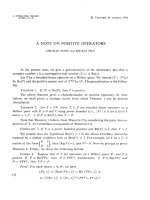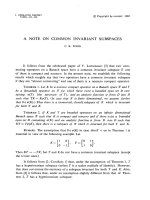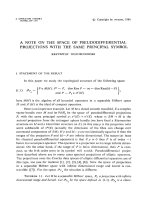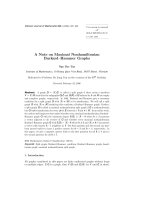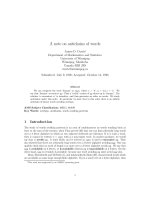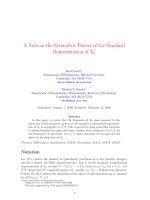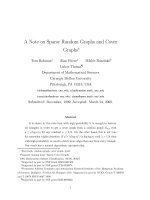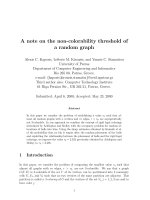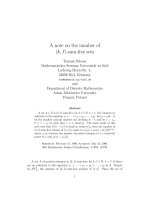Báo cáo toán học: "A note on random minimum length spanning trees" pps
Bạn đang xem bản rút gọn của tài liệu. Xem và tải ngay bản đầy đủ của tài liệu tại đây (108.79 KB, 5 trang )
A note on random minimum length spanning trees
Alan Frieze
∗
Mikl´os Ruszink´o
†
Lubos Thoma
‡
Department of Mathematical Sciences
Carnegie Mellon University
Pittsburgh PA15213, USA
,
,
Submitted June 28, 2000, Accepted August 11, 2000
Abstract
Consider a connected r-regular n-vertex graph G with random independent edge
lengths, each uniformly distributed on [0, 1]. Let mst(G) be the expected length of a
minimum spanning tree. We show in this paper that if G is sufficiently highly edge
connected then the expected length of a minimum spanning tree is ∼
n
r
ζ(3). If we
omit the edge connectivity condition, then it is at most ∼
n
r
(ζ(3) + 1).
1 Introduction
Given a connected simple graph G =(V,E) with edge lengths x =(x
e
: e ∈ E), let
mst(G, x) denote the minimum length of a spanning tree. When X =(X
e
: e ∈ E)isa
family of independent random variables, each uniformly distributed on the interval [0, 1],
denote the expected value E(mst(G, X)) by mst(G). Consider the complete graph K
n
.It
is known (see [2]) that, as n →∞, mst(K
n
) → ζ(3) . Here ζ(3) =
∞
j=1
j
−3
∼ 1.202.
Beveridge, Frieze and McDiarmid [1] proved two theorems that together generalise the
previous results of [2], [3], [5].
∗
Supported in part by NSF Grant CCR9818411 email:
†
Permanent Address Computer and Automation Research Institute of the Hungarian Academy of Sci-
ences, Budapest, P.O.Box 63, Hungary-1518. Supported in part by OTKA Grants T 030059 and T 29074
FKFP 0607/1999. email:
‡
Supported in part by NSF grant DMS-9970622. email:
1
the electronic journal of combinatorics 7 (2000), #R41 2
Theorem 1 For any n-vertex connected graph G,
mst(G) ≥
n
∆
(ζ(3) −
1
)
where ∆=∆(G) denotes the maximum degree in G and
1
=
1
(∆) → 0 as ∆ →∞.
For an upper bound we need expansion properties of G.
Theorem 2 Let α = α(r)=O(r
−1/3
) and let ρ = ρ(r) and ω = ω(r) tend to infinity
with r. Suppose that the graph G =(V, E) is connected and satisfies
r ≤ δ ≤ ∆ ≤ (1 + α)r, (1)
where δ = δ(G) denotes the minimum degree in G. Suppose also that
|(S :
¯
S)|/|S|≥ωr
2/3
log r for all S ⊆ V with r/2 < |S|≤min{ρr, |V |/2}, (2)
where (S :
¯
S)={(x, y) ∈ E : x ∈ S, y ∈
¯
S = E \ S}. Then
mst(G) −
n
r
ζ(3)
≤
2
n
r
where the
2
=
2
(r) → 0 as r →∞.
For regular graphs we of course take α =0.
The expansion condition in the above theorem is probably not the “right one” for
obtaining mst(G) ∼
n
r
ζ(3). We conjecture that high edge connectivity is sufficient: Let
λ = λ(G)denotetheedge connectivity of G.
Conjecture 1
Suppose that (1) holds. Then,
mst(G) −
n
r
ζ(3)
≤
3
n
r
where
3
=
3
(λ) → 0 as λ →∞.
Note that λ →∞implies r →∞.
Along these lines, we prove the following theorem.
Theorem 3 Assume α = α(r)=O(r
−1/3
) and (1) is satisfied. Suppose that r ≥ λ(G) ≥
ωr
2/3
log n where ω = ω(r) tends to infinity with r. Then
mst(G) −
n
r
ζ(3)
≤
4
n
r
where the
4
=
4
(r) → 0 as r →∞.
the electronic journal of combinatorics 7 (2000), #R41 3
Remark: It is worth pointing out that it is not enough to have r →∞in order to have the
result of Theorem 2, that is, we need some extra condition such as high edge connectivity.
For consider the graph Γ(n, r) obtained from n/r r-cliques C
1
,C
2
, ,C
n/r
by deleting an
edge (x
i
,y
i
)fromC
i
, 1 ≤ i ≤ n/r then joining the cliques into a cycle of cliques by adding
edges (y
i
,x
i+1
) for 1 ≤ i ≤ n/r. It is not hard to see that
mst(Γ(n, r)) ∼
n
r
ζ(3) +
1
2
if r →∞with r = o(n). We repeat the conjecture from [1] that this is the worst-case, i.e.
Conjecture 2 Assuming only the conditions of Theorem 1,
mst(G) ≤
n
δ
ζ(3) +
1
2
+
5
where
5
=
5
(δ) → 0 as δ →∞.
We prove instead
Theorem 4 If G is a connected graph then
mst(G) ≤
n
δ
(ζ(3) + 1 +
6
)
where the
6
=
6
(δ) → 0 as δ →∞.
We finally note that high connectivity is not necessary to obtain the result of Theorem 2.
Since if r = o(n) then one can tolerate a few small cuts. For example, let G be a graph
which satisfies the conditions of Theorem 2 and suppose r = o(n). Then taking 2 disjoint
copies of G and adding a single edge joining them we obtain a graph G
for which mst(G
) ∼
1
2
+
n
r
ζ(3) ∼
n
r
ζ(3) where n
=2n is the number of vertices of G
.
2 Proof of Theorem 3
Given a connected graph G =(V,E)with|V | = n and 0 ≤ p ≤ 1, let G
p
be the random
subgraph of G with the same vertex set which contains those edges e with X
e
≤ p.Let
κ(G) denote the number of components of G. We shall first give a rather precise description
of mst(G).
Lemma 1 [1]
For any connected graph G,
mst(G)=
1
p=0
E(κ(G
p
))dp − 1. (3)
the electronic journal of combinatorics 7 (2000), #R41 4
We substitute p = x/r in (3) to obtain
mst(G)=
1
r
r
x=0
E(κ(G
x/r
))dx − 1.
Now let C
k,x
denote the total number of components in G
x/r
with k vertices. Thus
mst(G)=
1
r
r
x=0
n
k=1
E(C
k,x
)dx − 1. (4)
Proof of Theorem 3
In order to use (4) we need to consider three separate ranges for x and k, two of which
are satisfactorily dealt with in [1]. Let A =(r/ω)
1/3
, B = (Ar)
1/4
so that each of Bα,
AB
2
/r and A/B → 0asr →∞. These latter conditions are needed for the analysis of the
first two ranges.
Range 1: 0 ≤ x ≤ A and 1 ≤ k ≤ B – see [1].
1
r
A
x=0
B
k=1
E(C
k,x
)dx ≤ (1 + o(1))
n
r
ζ(3).
Range 2: 0 ≤ x ≤ A and k>B– see [1].
1
r
A
x=0
n
k=B
E(C
k,x
)dx = o(n/r).
Range 3: x ≥ A.
We use a result of Karger [4]. A cut (S :
¯
S)={(u, v) ∈ E : u ∈ S, v /∈ S} of G is
γ-minimal if |(S :
¯
S)|≤γλ. Karger proved that the number of γ-minimal cuts is O(n
2γ
).
We can associate each component of G
p
with a cut of G.Thus
n
k=1
E(C
k,x
) ≤ O
∞
s=λ
n
2s/λ
1 −
x
r
s
= O
∞
s=λ
(n
2r/λ
e
−x
)
s/r
= O
∞
s=λ
(n
2r/λ
e
−x
)
s/r
ds
= O
rn
2
e
−xλ/r
x −
2r
λ
log n
,
and using Aλ ≥ ω
2/3
r log n we obtain
1
r
r
x=A
n
k=1
E(C
k,x
)dx = O
r
x=A
n
2
e
−xλ/r
x −
2r
λ
log n
dx
= O
A
−1
r
x=A
n
2
e
−xλ/r
dx
= O
rn
2
Aλ
e
−Aλ/r
= o(n/r).
We complete the proof by applying Lemma 1.
the electronic journal of combinatorics 7 (2000), #R41 5
3 Proof of Theorem 4
We keep the definitions of A, B and Ranges 1,2, but we split Range 3 and let δ = r.
Range 3a: x ≥ A and k ≤ (1 − )r,0<<1, arbitrary – see [1] (here =1/2 but the
argument works for arbitrary ).
1
r
r
x=A
(1−)r
k=1
E(C
k,x
)dx = o(n/r).
Range 3b: x ≥ A and k>(1 − )r.
Clearly
n
k=(1−)r
C
k,x
≤
n
(1 − )r
and hence
1
r
r
x=A
n
k=(1−)r
E(C
k,x
)dx ≤
n
(1 − )r
.
We again complete the proof by applying Lemma 1.
References
[1]A.Beveridge,A.M.FriezeandC.J.H.McDiarmid,Minimum length spanning trees
in regular graphs, Combinatorica 18 (1998) 311-333.
[2] A. M. Frieze, On the value of a random minimum spanning tree problem, Discrete
Applied Mathematics 10 (1985) 47 - 56.
[3]A.M.FriezeandC.J.H.McDiarmid,On random minimum length spanning trees,
Combinatorica 9 (1989) 363 - 374.
[4] D. R. Karger, A Randomized Fully Polynomial Time Approximation Scheme for the All
Terminal Network Reliability Problem, Proceedings of the twenty-seventh annual ACM
Symposium on Theory of Computing (1995) 11-17.
[5] M. Penrose, Random minimum spanning tree and percolation on the n-cube, Random
Structures and Algorithms 12 (1998) 63 - 82.

